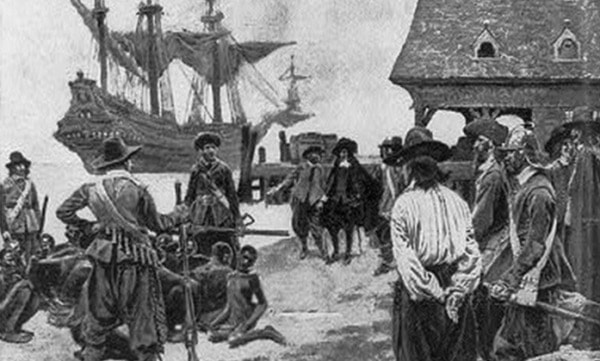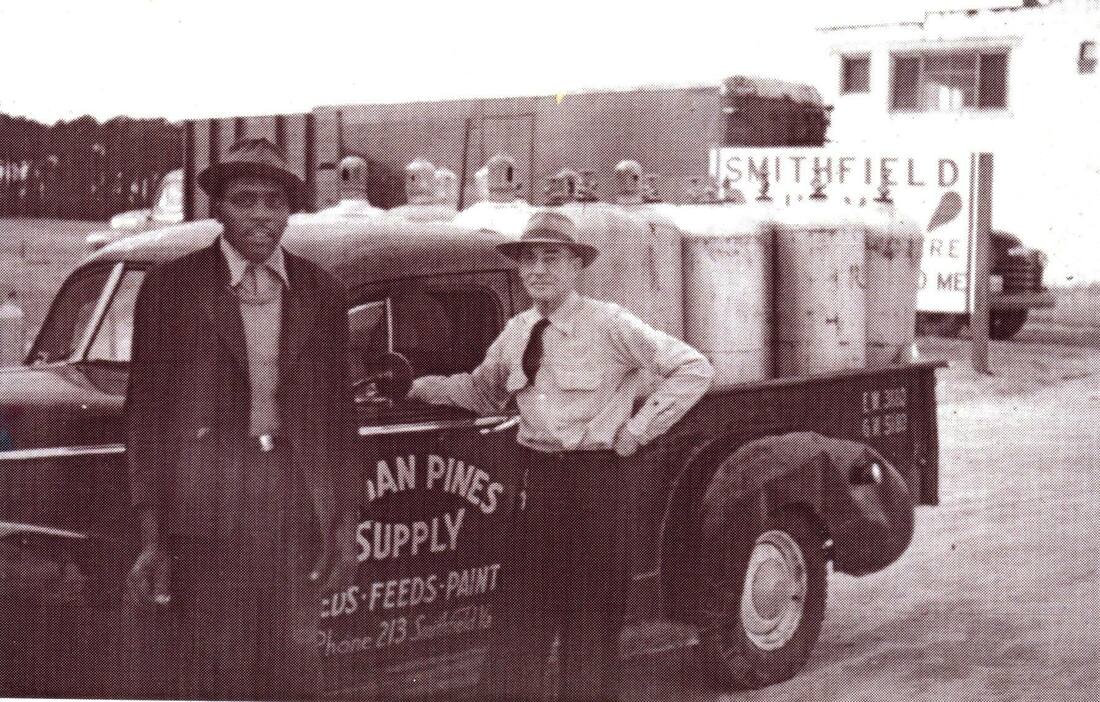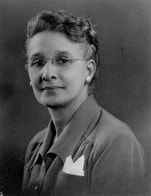The African-American Experience in Isle of Wight County
This online exhibit highlights historical records as well as notable individuals and groups
with photographs and items from the museum's collection.
To augment the museum's collection with your photographs, memories and documents, contact the museum
for an appointment to help preserve and interpret this important element of our county's history.
|
Africans arriving at Jamestown, 1619
Public domain via Wikimedia Commons Willis Atkins, left, was known to be the "strongest
man in Isle of Wight County." Circa 1950s. Georgie Davis Tyler
Retired from Isle of Wight County Schools in 1945 |
Recorded African-American history in English North America dates to August 1619 when the first Africans were involuntarily brought to the shores of Hampton Roads.
In 1623, Isle of Wight County, then Warraskoyack Shire, documents its first four Africans at Bennett's Welcome, the plantation belonging to Edward Bennett. The Emancipation Act was passed in Virginia in 1782. It allowed for the freeing of slaves by an owner either through a will at the owner’s death or while an owner was alive through a deed of manumission. Many slaves were freed by their owners as the result of this law. William Scott of Windsor, most likely a Quaker, freed 24 of his slaves the following year - on March 7, 1783. His neighbor Matthew Jordan freed four of his slaves on the same day. The first recorded black property owner in Isle of Wight County was Peter Beacock. In 1772, he purchased 50 acres of land from Joseph and Anne Goodrich. Timothy Tynes’ will of 1802, freed 62 of his slaves. It additionally left them livestock and a combined total of 4,750 acres of land, £900 and farm equipment. These families flourished, building homesteads, farming and working the water in the community. Today, there are many descendants of the Tynes families in Isle of Wight County. The U.S. Census showed that Isle of Wight County had 4,272 slaves in 1830. Taxed the same as livestock, a slave’s value was based on gender. By 1860, there were 1,370 free blacks living in Isle of Wight County. Many who owned property and ran businesses were lumbermen, farmers or watermen. When the Civil War came to Isle of Wight County, the population consisted of both free and enslaved people. The Confederate Army constructed a fort near Harden’s Bluff, across the James River from Mulberry Point, to fire upon Union vessels. The Confederate Army rented slave labor and hired free black laborers. Records of payment show that these men worked for 50 cents a day. In May 1861, Major General Benjamin Butler decreed that any male slave arriving at Fort Monroe would be considered contraband of war and not returned to his owner. As the war continued, hundreds of men, women and children escaped to Fort Monroe. In 1863, a unit of Colored Troops was assembled from the many contrabands living at the fort. The 36th Infantry United States Colored Troops was made up of mostly former slaves - including 11 from Isle of Wight County. On Sept. 1, 1864, it was documented that several free blacks traveled from Fortress Monroe to sail to Smithfield for the purpose of collecting their families, and on July 4, 1865, a boat of former slaves traveled from Fortress Monroe to the foot of South Church Street to celebrate Independence Day. Below are items and information from the museum's collection and from local residents pertaining to the African-American experience in Isle of Wight County. (Some images are protected for copyright purposes.) |
EARLY HISTORY
Virginia Gazette
|
Virginia Gazette
|
Josiah Parker
|
|
|
|
|
Will, Timothy Tynes
|
Tax Receipt, Andrew Woodley
|
Tax Receipts, William & Eliza Campbell
|
|
|
|
|
Tax Receipts, James Scott & Wife
|
Artifacts, Lawne's Point Free Black Homestead
|
Construction of Fort Huger
|
|
|
|
|
36th Infantry United States Colored Troops
|
Non-Payment, Fort Huger
|
Randall Booth Saves the Courthouse Records
|
|
|
|
|
U.S. Army
|
Nurse, Caregiver
|
Isle of Wight County
|
AGRICULTURE, BUSINESS & INDUSTRY
Agriculture
|
Peanut Industry
|
Business
|
Pork Industry
|
Farming
|
Businessman
| ||||||
| pretlow_biography.pdf | |
| File Size: | 116 kb |
| File Type: | |
HEALTH & EDUCATION
|
Educator, Writer
|
|
| |||||||||||||||||||
Mid-Wife
|
Educator
|
Education
|
|
|
| ||||||||
PUBLIC SERVICE
Elected Official
| |||||||||||||
| obituary_bradby.pdf | |
| File Size: | 87 kb |
| File Type: | |
Elected Official
James Banks Brown Jr.
1938-2015
A graduate of the Isle of Wight Training School and Howard University, James Brown had a career as a naval designer with the Norfolk Naval Shipyard. He served on the Isle of Wight County School Board and the Isle of Wight County Board of Supervisors until his retirement.
| obituary.pdf | |
| File Size: | 88 kb |
| File Type: | |
CHURCHES
Windsor
|
Smithfield
|
Smithfield
|
|
|
|
|
SPORTS, ENTERTAINMENT AND CULTURE
Basketball
|
Basketball
|
Composer, Minister of Music
| ||||||
| biography_ford.pdf | |
| File Size: | 905 kb |
| File Type: | |



